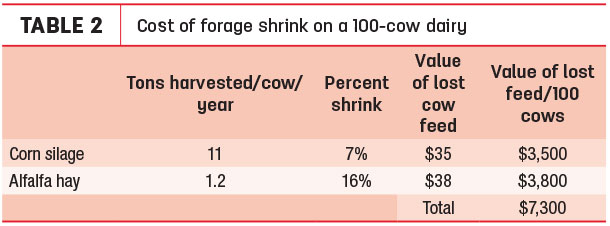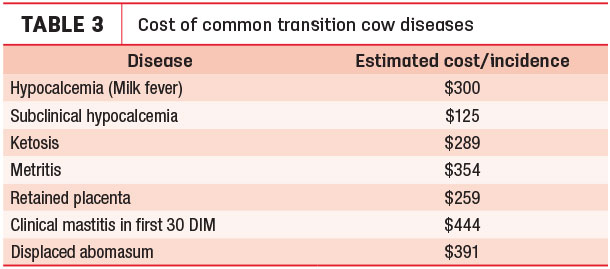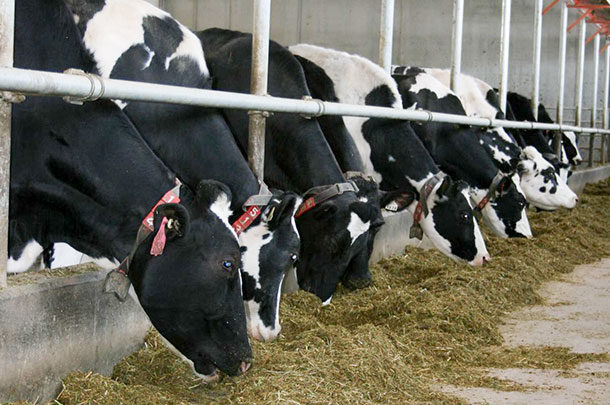Many cost-saving decisions are related to the feeding program. This seems logical given that purchased feed cost is the single largest expense on a dairy farm. The 2013 Cornell Dairy Farm Business Summary shows farms ranked in the top 20 percent for return on their assets spent 3.1 percent less on purchased feed and 3.7 percent less on farm-raised feed than the average farm. These top-performing farms also had higher milk production per cow. How can farms reduce feed cost without sacrificing production and income over feed cost (IOFC)?
Focus on forages
One way to make more milk while lowering feed cost is to focus on forage quality. Decisions related to making quality forages and minimizing dry matter loss during storage have a long-term impact. Forage is a significant component of the diet, making up to 50 percent or more of the dry matter fed. High-quality forages drive profitability. Forage quality is driven by a variety of factors, including selection of plant genetics, soil fertility, harvest management and crop storage.
Improving forage quality can improve IOFC by increasing milk production or decreasing the cost of purchased feed. Mean values for the average and top 10 percent of samples analyzed by Rock River Laboratory between June 2014 and June 2016 for crude protein, total tract neutral detergent fibre digestibility (TTNDFD), ash and starch in several forages are shown in Table 1. Farms that are consistently in the top 10 percent for the parameters listed are likely to have an impressive IOFC, because improving the quality of the forages will result in higher dry matter intakes, improved rumen function and improved milk yield.
Crude protein, ash and starch are important aspects of forage quality. The supply of energy and protein determines how much milk production a ration can support. Forages that are higher in protein will generally support higher levels of milk production. Ash, fibre digestibility and starch impact the energy density of forages, making these important metrics to evaluate when striving to produce high-quality forage.
A newer tool developed by David Combs, Ph.D., at the University of Wisconsin called “TTNDFD” can be particularly helpful in evaluating forage quality. This equation considers how much fibre is digested, how fast the fibre is digested and how long the fibre remains in the cow’s digestive system. Forages with a high TTNDFD value will support more milk production per pound of dry matter than forages with an average level of TTNDFD. Profit-minded dairy producers monitor the parameters listed in Table 1 and aim to make forages that are in the top 10 percent.

Minimizing forage loss during storage and feeding can also have a significant impact on feed cost. It is estimated that 14 percent of the forage that is grown in the U.S. is never consumed by animals because it is lost during harvest, storage or feeding. The value of this forage is estimated at more than $3 billion. The value of the forage that is lost on-farm can add up. Consider the scenario shown for a 100-cow herd in Table 2, where corn silage is valued at $45 per ton and alfalfa hay is valued at $200 per ton. On this farm, the value of the feed that was never fed because it was lost totaled $7,300. Profit-savvy dairy managers focus on reducing the losses of feed during storage and feeding, and the savings add up.

Focus on transition cows
Another way to make more milk with lower cost is to focus on transition cows. During economically challenging times, it can be tempting to reduce the amount of money spent on non-lactating animals. However, the transition cow ration is one of the most important rations on the farm, and a failure in the transition cow program has a great impact on dairy farm profitability. The cost of transition cow diseases is significant. Table 3 shows the cost per incidence of several common transition cow diseases.
In addition to having a lower incidence of disease, cows on a well-managed transition cow program have higher dry matter intakes, achieve higher peak milk and may have improved reproductive performance. Compromising the success of the transition cow program by reducing the cost of their diet can have significant and long-lasting impacts on these cows during their next lactation.

Even the shrewdest dairy managers recognize that investing in transition cows will pay a huge return on their investment, and they will not risk reducing profits by cutting corners in their transition cow ration.
Evaluating feed additives
Top managers also take care to select feed additives that will improve their bottom line and increase IOFC by improving the performance of their cows. There are a wide variety of ingredients that can be added to the ration, and deciding which ones will create a positive return on investment can be overwhelming.
Mike Hutjens, Ph.D., University of Illinois, recommends a strategy he calls the “4-Rs” for evaluating feed additives. This strategy includes evaluating the anticipated response, economic return, available research and field responses. Dairy managers can use this approach to determine which feed additives are likely to result in a positive return on investment.
When looking at the anticipated response, it is important to understand how a cow is likely to react when her diet is supplemented with a feed additive. Possible responses might include improvements in the following: rumen function, health, immune function, fertility, feed efficiency, milk production, etc. If the additive is not going to offer a desired response, then it is not a good fit.
When considering the economic return offered by a feed additive, the cost of feeding the additive is compared to the expected improvement in income as a result of feeding this product. The benefit must outweigh the cost; if not, then a reduction in IOFC will occur.
Evaluating the quality and quantity of research on an additive is another important factor. Key questions to ask include:
- How many research trials have been conducted on this product?
- Were these trials conducted at universities or other unbiased research facilities?
- Are the results consistent between trials?
Independent, unbiased research trials that show similar responses in multiple trials have a greater likelihood of success than products with limited or inconsistent findings between trials.
Considering the statistical significance of the data is important as well. One tool that is used to show statistical significance is a p-value. When two data points are compared and the p-value is less than 0.05, the difference between the two points is considered to be statistically significant. If the p-value is greater than 0.05, the difference between the data points is not considered statistically significant. For example, if a feed additive is being tested to determine if it will increase milk production and the cows fed the feed additive produced 1.4 kilograms more milk than cows not fed the additive with a p-value of less than 0.05, this difference would be considered statistically significant.
The final “R” to consider is field responses. When considering the field responses, ask what metrics can be used on your farm to measure the response to the additive. Measuring on-farm responses can be tricky, because there are many factors that can impact the performance of cows over time, including changes in forage quality, weather, environment and days in milk (DIM). So it is important to choose metrics to measure responses that account for these changes. There is great value in proving an additive is generating an improvement with data from your own farm. This can increase your confidence that this additive belongs in the ration.
Considering the “4-Rs” collectively is a very useful means of evaluating feed additives and selecting the ones that are most likely to improve your bottom line. This method makes the task of sorting through all of your options much more logical and systematic, and increases your likelihood of making the best decision.
Dairy managers should work closely with their nutritionist, veterinarian and other trusted advisors to help make decisions related to improving forage quality, reducing forage shrink and investing in transition cows. The feed additives included in the ration should be evaluated using the “4-Rs” to determine if they are beneficial and increasing IOFC. Making wise decisions in these areas can have a significant impact on keeping feed costs in line and increasing bottom line profits even during tough economic times. PD
References omitted but are available upon request. Click here to email an editor.
Scott Bascom, Ph.D., is a dairy technology manager with Phibro Animal Health with 20 years of experience as a dairy cattle nutritionist.

-
Scott Bascom
- Dairy Technology Manager
- Phibro Animal Health Corp.
- Email Scott Bascom
PHOTO: Be careful not to sacrifice income when cutting feed costs. Staff photo.









